The response of deltaic systems to climatic and hydrological changes in Daihai Lake rift basin,Inner Mongolia, northern China
Yu Xinghe , Li Shunli Tan Chengpeng Xie Jing Chen Bintao Yang Fan
1.School of Energy Resources, China University of Geosciences (Beijing), Beijing 100083, China
2.Research Institute of Petroleum Exploration & Development, PetroChina, Beijing 100083, China
1 Introduction*
As major hydrocarbon-bearing basins in eastern China,the lacustrine rift basins contain many deltas on the slope zone, where sandy sediments, reservoir-cap assemblages and lithologic traps, and petroleum accumulations are abundant.Effective petroleum explorations in these ancient lacustrine rift basins require geologists understand and forecast the distribution of depositional facies and the internal characteristics of reservoirs (Qiang and McCabe,1998; Zhuet al., 2005; Jianget al., 2007).Daihai Lake,a lacustrine graben or rift basin, is an important analog for understanding the subsurface characteristics of deltas and sandbody distribution.The lacustrine rift basin constrains a combination of varied geological processes.For instance, the tectonic setting formed by different geodynamic mechanisms controlled the distribution of depositional systems.The sediment supply and climatic changes influenced the features of sandbodies within these depositional systems.The investigations of genetic mechanism and sedimentary evolution of modern lacustrine rift basins led to the advanced study in depositional difference, processes of sedimentation, and distribution of sedimentary facies in various tectonic settings (Coleman, 1982; Cohenet al., 1986; Barr, 1987; Qiu, 1992; Konateet al., 1994;Johnsonet al., 1995; Blair and McPherson, 1998, 2008;Fisheret al., 2008).
The analogy of deltaic sedimentations in lacustrine rift basins with comparable geological settings has been studied extensively around the world, most notably in eastern Africa (Crossley, 1984; Cohen, 1990; Scholz and Rosendahl, 1990; Johnsonet al., 1995; Soreghanet al.,1999; Wellset al., 1999)and Lake Baikal (Hutchinsonet al., 1992; Hans Nelsonet al., 1999).Due to the high rate of subsidence in rift basins, coarse-grained deltas are predominant on slopes with steeper nearshore gradients,such as fan deltas and braided fluvial deltas (McPhersonet al., 1987, 1988; Nemec and Steel, 1988; Orton, 1988;Yu, 1994, 1995; Yu and Wang, 1997).Fine-grained deltas were mainly developed at the axial shoaling margins with relatively gentle slope gradients, where the trend of border fault was orthogonal to the shore line.In order to research the distribution of syn-rift depositional systems in lacustrine rift basins, this article analyzed the modern climatic conditions, palaeotectonic activities, and facies stacking which provided insights for understanding the distribution of reservoirs in analogous basins.
The Daihai Lake, the focus of this study, receives sediments through thirteen streams which have developed thirteen prominent subaerial deltas.Nine of them are located in the northern side of the lake, two deltas are in the southern side of the lake, and two deltas are in the eastern and western sides of the lake respectively.The five deltas examined in this research (Yuanzigou delta, Bantanzi delta, Bulianghe delta, Tianchenghe delta, and Muhuahe delta)were selected on the basis of tectonic setting and their distribution along the axis of the lake.Two of the coarse-grained deltas(Yuanzigou delta and Bantanzi delta)are on the northwestern Daihai Lake with steeper slope gradients, two coarsegrained deltas (Bulianghe delta and Tianchenghe delta)are on the southern part of the lake with relatively gentle slope gradients, and one fine-grained delta (Muhuahe delta)is on the axial shoaling margin of the lake.The objectives of this study are (1)to determine the controls on depositional systems by structure and evolution of lacustrine rift basin,such as the distribution of fault systems, genetic mechanism of the basin; (2)to analyze the influence of recent climatic and hydrological changes on both the water level and the sediment supply; and (3)to identify sedimentary successions of deltas to explain the distribution of sandbodies in terms of how the tectonic, climatic and hydrological changes affected the depositional systems.
2 Regional geologic setting
Daihai Lake is located in the Liangcheng County(40°29′27″-40°37′06″N, 112°33′31″-112°46′40″E).The Manhan Mountain with a maximum elevation of 2288 m is located in the north of the lake; and with strike of 60°,there is the footwall block of the northern border fault system (Fig.1).The Matou Mountain in the south of the lake with the approximately maximum elevation of 1600 m is comprised of hills.The basin covers an area of 653.3 km2and relates catchments of 2289 km2.Daihai Lake covers 86.5 km2with an elevation of 1218 m above sea level and the maximum water depth of 16.05 m.The lake is in a delicate state of hydrologic balance; all of the annual water loss is through evaporation, which results in water salinity of 4 g/L.
The Archean and the Cenozoic Formations occurred around the lake (Fig.1), lack of the Paleozoic and Mesozoic strata.Adjacent to the major border fault of the basin in the northwestern side, the high-rise of rift-related highlands consisted of the Archean granite gneiss, while the mountain ranges in southeastern side were composed of the Tertiary basalt.The ephemeral rivers of drainage have built modern alluvial fans at the front of mountains and deltas along the margin of the lake with thickness from 100 to 240 m.
Daihai Lake was formed during the Late Pliocene to the Early Pleistocene (Li, 1972).A series of northeastern faults with the confined grabens had been developed in the southern Inner Mongolia due to the Himalayan movement.The rift system which includes Daihai Lake, Huangqihai Lake, and Erhai Lake is 150 km long and 15 to 20 km wide (Fig.1).The structural framework of Daihai Lake was principally controlled by northeastern and southeastern faults.Due to different intensity of faults′ activities, the hanging-wall block in the northern side of the lake exhibits steeper slope gradients than the one in the southern side.In addition, the basalt in the southern side of lake indicates that the fault systems were active before Daihai Lake was formed.
3 Climate and hydrology
The Late Pliocene was the early stage of basin formation when reddish weathered crust was formed due to the arid climate.During the Early to Middle Pleistocene, the climate was relatively arid with the outwashes as the primary sediments.During the Late Pleistocene to Early Holocene,the climate in the region of Daihai Lake basin turned into frigidness with the occurrence of active frost formation (Li,1972; Jin, 2001).The slide structure on Tianchenghe delta section in the south of Daihai Lake was an example of thefrigid climate (Fig.2).Subsequently, the climate became humid with several ephemeral frost events.The isotopic and palynologic features from the drilling data in Daihai Lake suggested that the climate changed from moisture to frigidness, and then, into humidity (Caoet al., 2000).
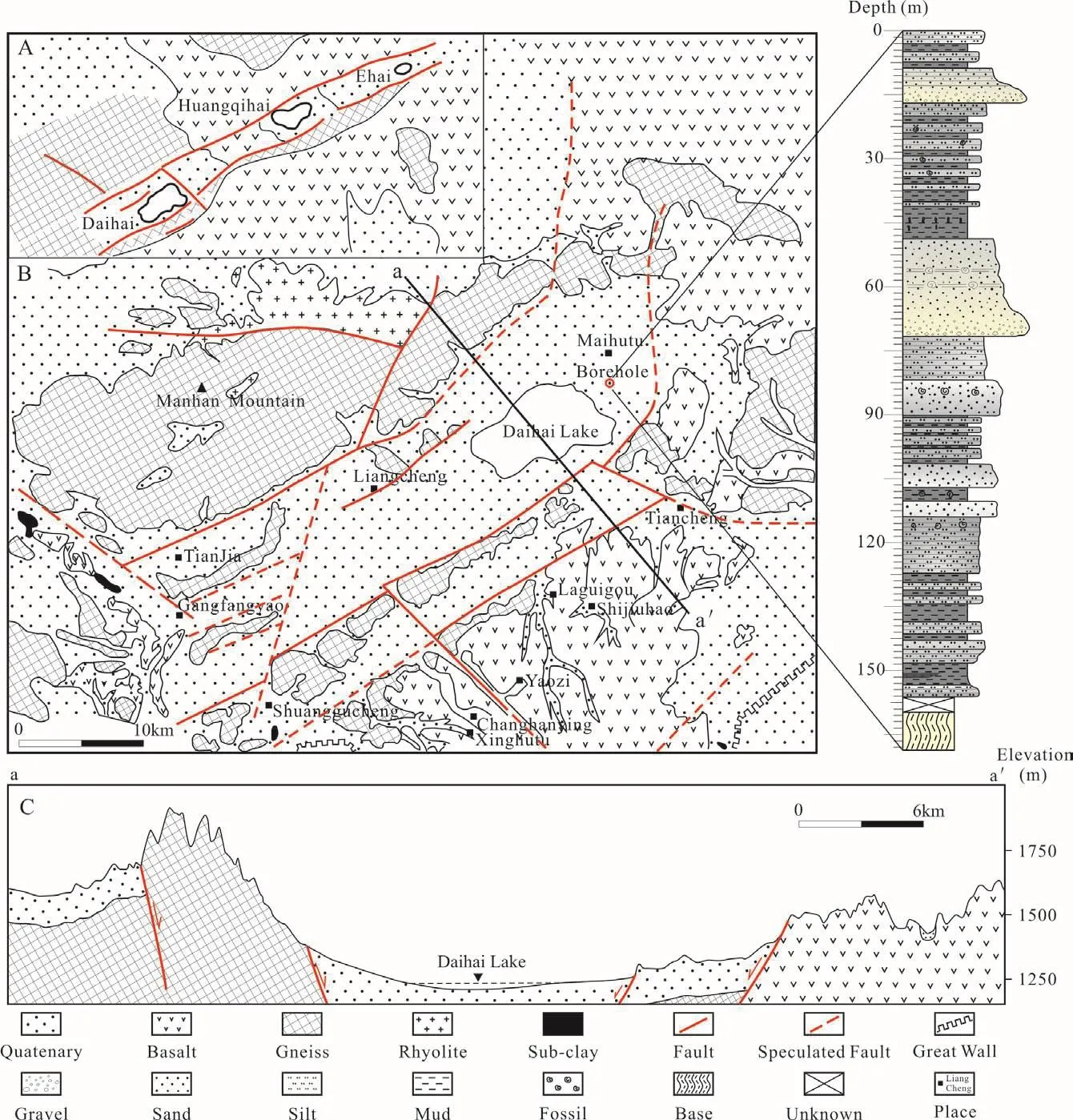
Fig.1 Schematic diagram of Daihai Lake in the northern China showing regional setting, lithologic column of borehole (Li, 1972),and regional profile section.A-Rift system formed by a series of the northeastern faults; B-Regional geology situation of Daihai Lake;C-Cross section of Daihai Lake.
Daihai Lake is located in the sub-humid and semi-arid continental monsoon zone with cool and dry climate.Over the last ~ 100 years, the climate has transformed from relatively warmness to coldness and dryness (Caoet al., 2000).During this period, Daihai Lake underwent the changes of humid-arid-humid-arid climates (Wanget al., 1990).Meteorological data in the past fifty years in the Daihai region suggest that the evaporation was much greater than the rainfall.The rainfall within Daihai Lake basin started to decrease during the 1960s, and the average annual rainfall was 388.5 mm since the 1980s.In Daihai Lake ba-sin, the rainy season lasts from June to September which commonly rains with a shrot duration and large water volume.Daihai Lake is located in the eastern Asian monsoon region with a high elevation, thus, strong northwest to southeast winds blow from April to June.Daihai Lake is a typical high-latitude inland lake and its inflow water mainly depends on rainfall and surface runoff (ephemeral rivers).The area of Daihai Lake is gradually decreasing,from 177.5 km2in 1950 to 86.5 km2in 2011.Accordingly,the elevation of lake level decreased seven meters from 1225 m in 1950 to 1218 m in 2011 (Fig.3).
4 Methods and data
The five deltas were examined in this study, which represent characteristics of depositional systems around Daihai Lake because they are located within various geological settings.Yuanzigou delta and Bantanzi delta are on the northwestern steep slopes with an area of 2.8 km2and 1.4 km2respectively and they have fan-shape.Bulianghe delta and Tianchenghe delta are on the southern gentle slopes with an area of 9.0 km2and 7.8 km2respectively and they have lobe-shape.Muhuahe delta, the largest one in Daihai Lake with an area of 10.4 km2, is located on the shoaling margin as a cuspate and bird-foot shape.These analyses of distribution and external geometry were based on remote images.
In the field study, 103 trenches were dug on the different parts of deltas in order to determine sedimentary successions, to observe lithology and grain-size of sediments,and to identify sedimentary structures and bounding surfaces.The interval of trenches is 100 to 200 m with the dimension of 1 m (width)× 2 m (length)× 2 m (depth).Typical sedimentary photos were taken and integratedlithologic columns were depicted in field including color,grain size, composition, sedimentary structures, and size grading of sediments.In trenches, 1092 sediment samples were collected for grain size analyzing (vertical interval is 10-20 cm).In order to keep the original textures of some typical samples, resins were impregnated into sands prior to sample collecting.

Fig.2 Slide structures on the Tianchenghe delta section in the southern Daihai Lake.A-Slide structure with small-scale detachments;B-Slide structures with compressional deformation.
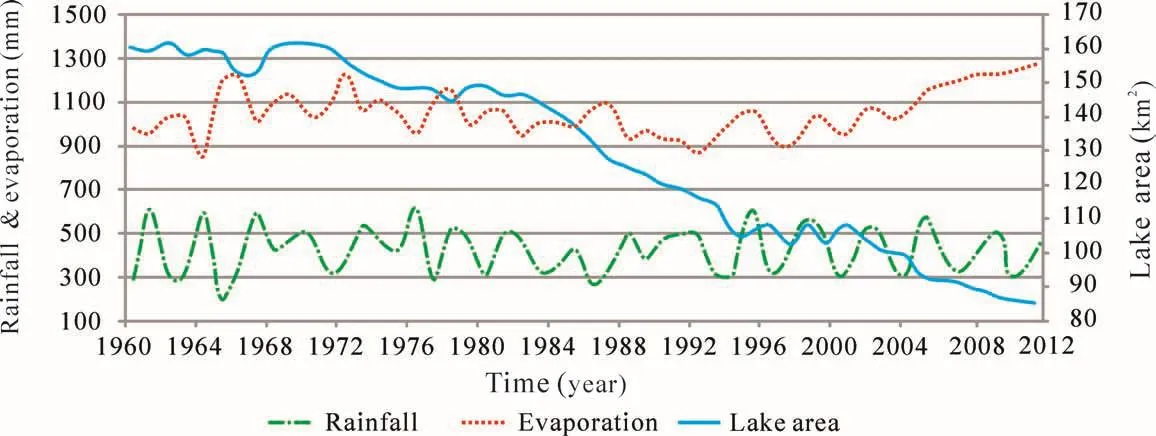
Fig.3 Changes of rainfall, evaporation and the region of Daihai Lake since 1960s.Six stages of evaporation changes are noted for the past 50 years: (1)rapid increasing period (1960 to 1966); (2)fluctuation with low amplitude period (1966 to 1978); (3)stabilization with moderate fall period (1978 to 1987); (4)rapidly decreased period (1987 to 1993); (5)fluctuation with moderate rise period (1993 to 2004); (6)rapidly increased period (2004 to present).
In the laboratory work, the study mainly included determination of grain size, identification of bounding surfaces,and prediction of sandbodies.Firstly, grain size distribution curves from numeral samples were obtained by using the Marlvern laser particle size analyzer.Secondly, profiles of deltas were established by integrating stratigraphic columns and determining bounding surfaces.Finally distribution of sedimentary facies and sandbodies were predicted.
5 Depositional systems in Daihai Lake
5.1 Distribution of depositional systems
There are thirteen deltas around Daihai Lake, which prograde toward the lake in the elongated, lobate, and cuspate shapes.In the basin, the profile from north to south is asymmetrical that results in a distinct difference of depositional systems between steep slope and gentle slope.The northern area was uplifted and the terrain was steep.Alluvial fans are located along the piedmont, which are overlapped with each other to develop bigger alluvial fan aprons.In the front of alluvial fan aprons, several ephemeral rivers formed some smaller and coarse braided fluvial deltas in elongated shapes.As the primary depositional system, deltas spread as lobate shape with a large scale in the southern gentle slope.Nowadays, the Bulianghe delta covers an area of 9.0 km2, and the Tianchenghe delta contains 8.8 km2of land.However, the area of Yuanzigou delta is only 2.8 km2and the area of Bantanzi delta is merely 1.4 km2.It can be perceived that the area of deltas on the gentle slope is much larger than those on the steep slope.In addition, the numbers of deltas are distinctly different between steep and gentle slope.There are nine deltas in the northern slope of Daihai Lake; in contrast, there are only two deltas on the southern slope.In conclusion, the obvious attribute of distribution of delta systems in the fault lacustrine basin is that “l(fā)arger number of fan-shape deltas with smaller scale were developed on the steep slopes;smaller number of lobe-shape deltas with larger scale were formed on the gentle slopes” (Fig.4).On the eastern side of rift axis, Muhuahe River, the biggest one in this area with a large drainage system, is an ephemeral river in the strict sense, which generated a cuspate-shape delta.The Muhuahe delta is the biggest one with an area of 10.4 km2.On the western side of rift axis, Gongbahe River and Wu-haohe River were perennial rivers ten years ago.However,due to the arid climate and reservoir construction, the rivers withered away.
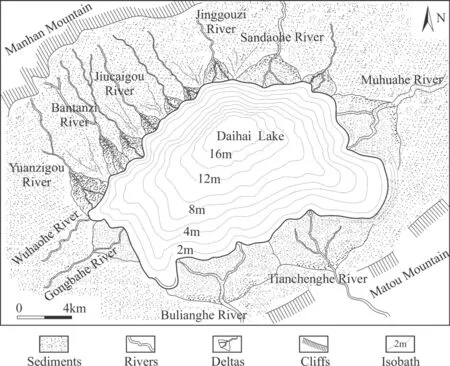
Fig.4 Distribution map of fluvial delta systems in Daihai Lake basin.Thirteen primary ephemeral rivers have developed deltas around Daihai Lake.
5.2 Sedimentation of deltas
According to sedimentary facies and sedimentary characteristics of deltas, the five deltas can be divided into three types: Yuanzigou delta and Bantanzi delta are gravelly braided fluvial deltas on steep slope, Bulianghe delta and Tianchenghe delta are sandy braided fluvial deltas on gentle slope, and Muhuahe delta is a sandy (fine)normal delta on the axial shoaling margin (Table 1).
5.2.1Gravel braided f luvial deltas: Yuanzigou delta and Bantanzi delta
Yuanzigou delta and Bantanzi delta are gravelly braided fluvial deltas, which are close to the source area with a transport distance of about 7 to 8 km on the steep slope(average gradient is 7°), located in the northern side of the lake.The rivers supply sediments with ephemeral and granitic gneiss fragments as the primary sediment.As the deltas are close to source area, the grain size is much coarser.Sediments in distributary channels with varying size of 0.1 to 0.5 m mostly are pebbles oriented in the flow direction.The main sedimentary structures are massive, tabular crossbedding and trough cross-bedding with scours.However,as the gradient of slope at the delta front was higher, wave process was stronger and sediments were reworked by waves.
Braided distributary channels with fining-upward successions are predominant on the delta plain (Fig.5A).Because of numerous bars, channels with coarse grain sediments branch out and converge together frequently.In contrast, sheet sand layers are dominant in the delta front.Influenced by gradient and inertia-effect, the coarse grain sediments unload rapidly at the estuary; in addition, deltas prograde into the lake constantly to form the coarseningupward sequences in the delta front (Fig.5B).
The depositional slope of Yuanzigou delta with a strong fluviation was gentler than that of Bantanzi delta.Thus,the grain size in Yuanzigou delta was coarser than the one in Bantanzi delta.The wave ripples in Yuanzigou delta are more common than that in Bantanzi delta due to wave activity driven by the monsoon.Although it only developed in the east side of the Yuanzigou delta, these wave ripples were also affected by southeast winds.
Nearshore morphology and sediment patterns vary significantly between the two types of deltas.Slope gradients of the Yuanzigou delta located at the border fault are steeper than those of the Bulianghe delta situated on the shoaling margin.Although both of them exhibit a well defined lobe-shape on lake-ward margin, the width and spatial extension of these deltas are different due to the reworking of the wind-generated waves of Daihai Lake.The Bulianghe River has a more massive subaerial delta than the Yanzigou River, partly because it is situated on the southern gentle slope margin with a larger terminal splay, but also due to its higher rate of sediments discharge.As a result,much of the coarse grain bed load of Bulianghe River was deposited on the delta plain, leaving a predominantly fine grain suspended load at the delta front.In comparison, the highly confined space for subaerial deposition combining with the narrow shelf and steeper slope gradient provide the setting for rapid dispersal of coarse grain sediments in the steep slope offshore of the Yuanzigou River.Combining vertical log data and cross profiles, it is possible to reconstruct spatial architectural elements variations and 3D models of the deltas (Fig.6).
The down-slope flow dominated delta (Yuanzigou delta)consists of some facies assemblages of alluvial fan.The border-fault setting allows coarse grain sediments to be delivered to the delta front during flood period.Due to the steeper slope gradients, the delivery from the Yuanzigou River of a mixture of gravel, sand, and mud to the near shore and delta front is probably the reason for promoting a range of gravity-driven sediment transport process (Wellset al., 1999).Influenced by gradient and inertia-effect, the coarse grain sediments unloaded at theestuary rapidly; furthermore, deltas prograded into lake constantly and formed the coarsening-upward sequences of the delta front.The effect of waves on the eastern side with the movements of feeder channels formed westward long-shore drift and asymmetric variation of facies distribution (Fig.6).

Table 1 Classification of deltas around Daihai Lake
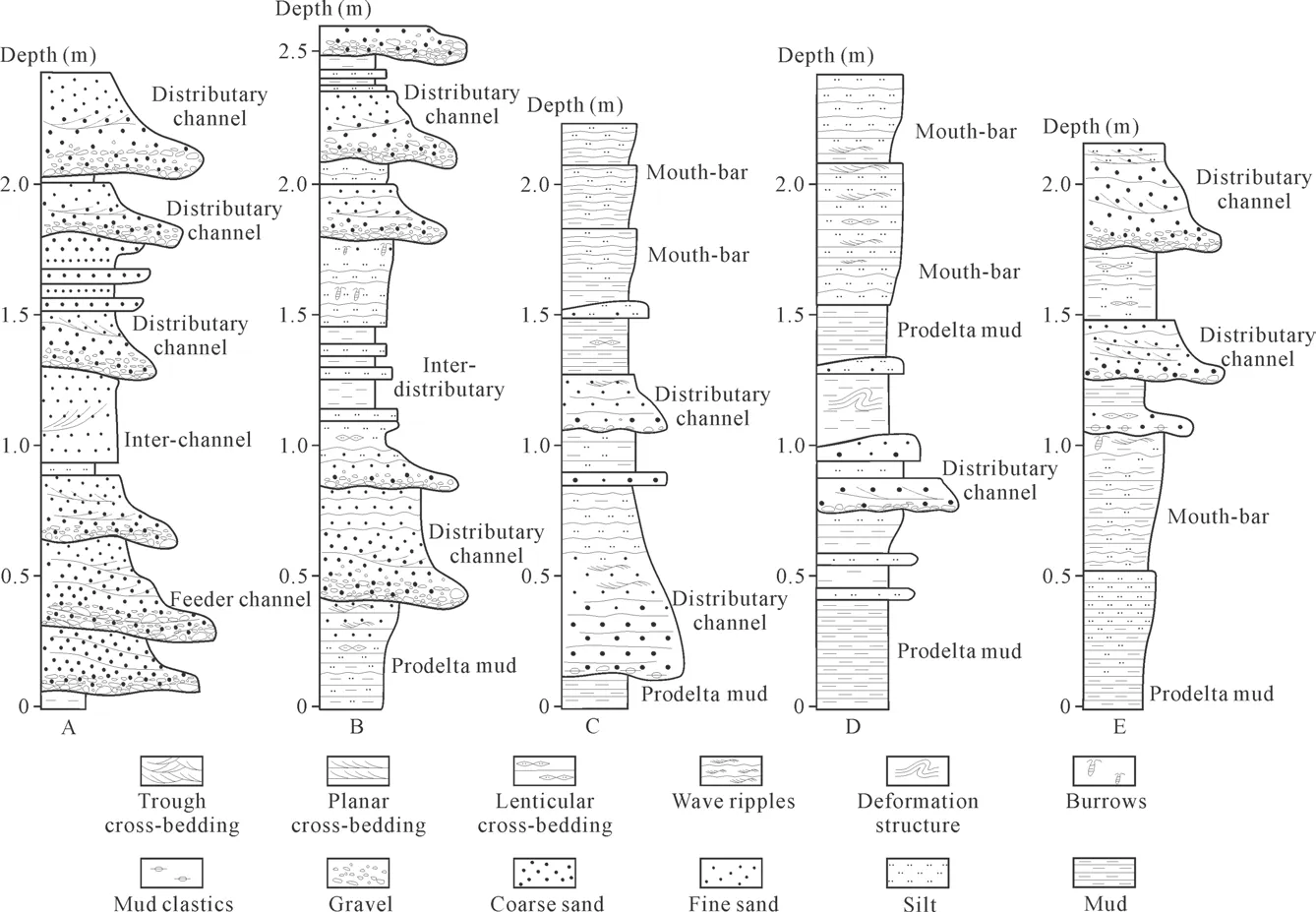
Fig.5 Sedimentary sequences of deltas in Daihai Lake.A-The Yuanzigou delta, fining-upward succession with high content of pebbles and erosional surfaces; B-The Bantanzi delta, obvious coarsening-upward succession with gravels, wave ripples and burrows;C-The Bulianghe delta, fining-upward succession at the lower portion of the sedimentary sequence and coarsening-upward succession in the upper poriton, the grain sizes range from fine to gravel sand; D-The Tianchenghe delta, coarsening-upward succession with relative fine grain sediments; wave ripples, slide structures and burrows are common in fine or silt sand layers; E-The Muhuahe delta,coarsening-upward succession with fine grain sediments; wave ripples, mixed bedding and burrows are common in delta front.
5.2.2Sandy braided f luvial deltas: Bulianghe delta and Tianchenghe delta
Bulianghe delta and Tianchenghe delta are located at the southern side of Daihai Lake.The grain size of these deltas is finer than deltas on north slopes due to the 15 to 30 km relatively long distance sediment transportation.The average gradient of the southern depositional slope is 2°to 3°.The rivers that feed the deltas are also ephemeral streams with a large range of grain size distributions; these rivers dry up during the arid seasons.Braided distributary channels with gravel, gravel-sand and coarse-sand were common in delta plain.Pebbles in channels were moderately rounded with diameters of 0.05 to 0.1 m.Massive bedding, planar cross-bedding and trough cross-bedding were the main sedimentary structures.Fine grain, silt and mud sedimentation were developed in delta front.The silt deposit was characterized by ripples and laminations (Figs.5C, 5D).
Similar to the northern deltas, Bulianghe delta and Tianchenghe delta have large-scale channels with moderate sinuosity.Sedimentary successions in channels were fining upward with erosional surfaces and lag sediments.Sedimentation of the delta front was characterized by interbeds of mud layers and fine-sand layers with ripples.The dark gray mud layers at the bottom of the sedimentary sequence indicates the coarsening-upward succession of the delta front.Sandbodies were widespread in the delta
front with good connectivity due to the gentle slope gradients.Gentle slopes are not conducive to develop wave ripples as the decay of wave energy.Therefore, the appearances of wave ripples on gentle slopes are less than those on steep slopes.The profile section indicates that the wave ripples of the Tianchenghe delta were formed in an early period when it had a steep slope.In other words, the height and length of wave ripples could reflect gradients of slope.The higher and shorter the wave ripples, the steeper the slope gradients, and vice versa.
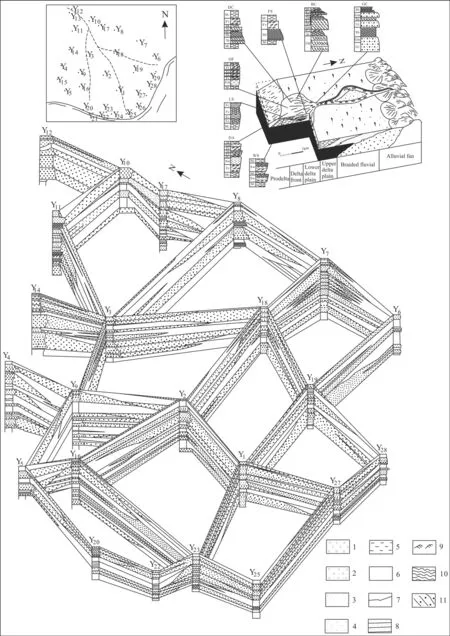
Fig.6 Depositional model and fence diagram of the Yuanzigou delta showing the distribution of sedimentary facies.1-Gravel;2-Sandy gravel; 3-Sand; 4-Fine sand; 5-Mud; 6-Silt sand; 7-Boundary of elements; 8-Parallel bedding; 9-Ripple; 10-Waves;11-Planar cross bedding.
5.2.3Sandy (fine)normal delta: Muhuahe delta
Muhuahe delta is located at the eastern side of Daihai Lake next to the Maihutu town.Sediments in this delta are fine and well rounded grains as the result of long distance(more than 50 km)transportation from the source area.The Muhuahe River is a stable stream with moderate sinuosity.Fine- to coarse-grain sands with trough cross-bedding,planar cross-bedding and mixed bedding are common in channels of the delta plain.Silt or muddy-silt layers with wave ripples are developed in the delta front (Fig.5E).
Sedimentary successions of the Muhuahe delta were coarsening upward with some isolated fining-upward channel deposits.Erosional surfaces and lag sediments were common in channel sedimentation.The wave ripples in the delta front suggest that coastal waves reworked the sediments and formed distal bar along the shoreline with high connectivity.However, from 1988 to 1993, the evaporation of Daihai Lake was low while discharge of the Muhuahe River was high.The shape of the Muhuahe delta was bird-foot like because of greater fluvial influence than wave action.Subsequently, with the high rate of evaporation and strong wave action, the shape of the Muhuahe delta became cuspate.Thus, when the evaporation decreased,the delta was fluvial-dominated with distributary mouth bars in the delta front because of the strong fluviation.In contrast, the delta was wave-dominated with distal bars along shoreline as evaporation increased.
5.3 Evolution of depositional systems
Even successive deposition of deltas has been developed since Daihai Lake was formed, the fluctuations of water level were driven by climatic variations in precipitation-evaporation balance which contributed to the complex facies stacking pattern and evolution of depositional systems.The terraces of Tianchenghe delta in the southern side of the lake are evidences of recent active deposition (Fig.7).The first terrace was formed 2000 years ago,which was determined by14C dating (Wanget al., 1990),representing a significant reduction of the lake area and fall of lake level.Since then, the expanse of the lake has never been up to its maximum area of 209 km2.The second terrace was developed during the 1970s when the lake area was 145 km2due to the low rainfall and high evaporationin 1972 (Fig.3).The third terrace is the present delta plain of the Tianchenghe delta.Three mud layers observed on trench profiles reflect lake-flooding in history.Therefore,the terraces reflect the shrinking of lacustrine basin and delta progradation; the draped mud layers indicate the rising of water level and flooding.
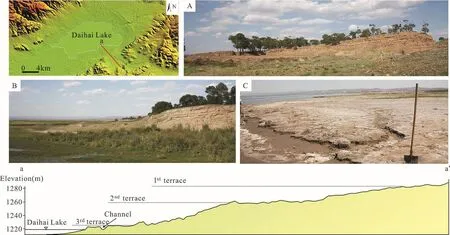
Fig.7 Terraces of the Tianchenghe delta in the south of Daihai Lake.A-The 1st terrace was formed 2000 years ago; B-The 2nd terrace was formed in the 1970s; C-The 3rd one is the present delta plain of the Tianchenghe delta.
In the past 30 years, the water level and the area of Daihai Lake have decreased with delta progradation as a result of increasing evaporation (Fig.8).The changes of depositional systems happened in the southern and eastern sides of the lake.The area of the Muhuahe delta has increased since the 1990s, and became the largest one in Daihai Lake basin.Bulianghe delta and Tianchenghe delta have converged since 2000.One of the reasons is that the slopes in southern and eastern sides of the lake are gentle; therefore, deltas are exposed rapidly as vertical lake level fell.Another reason is that the Muhuahe River, the Bulianghe River and the Tianchenghe River are relatively sustained rivers with large volume of sediments for constructing deltas.In the meantime, deltas in the northern side of the lake were prograding with small scale as well.
The interaction between down-slope flows and alongslope currents was also influenced by the climate.Fluviation was greater than coastal wave action in rainy seasons due to high discharge from the rivers and sediment supply.Deltas prograded lakeward while the lake area was decreased and distributary mouth bars were developed in the delta front.During the period of 1993 to 2004, the rainfall was fluctuating with the moderate growth of evaporation.Deltas were constructed by abundant sediment supply.In 1995, the rainfall in Daihai Lake basin was 600.9 mm.The Muhuahe delta has the bird-foot shape due to the high discharge and sediment supply from the Muhuahe River(Fig.8).Since 2004, the evaporation escalated rapidly and resulted in a continuous reduction of the lake area.In 2006, the discharge of the Muhuahe River was considerably decreased because of less rainfall and irrigation.The delta front of the Muhuahe delta was cuspate shape and the sediments were reworked by coastal waves (Fig.8).
6 Discussion
The formation of Daihai Lake and the evolution of depositional systems were driven by various complicated geological agents.This article is attempting to demonstrate the influence of tectogenesis, climatic changes, and hydrology on the development of deltas.The tectonic framework of Daihai Lake is controlled by tectonic movement which determined the generation of the depositional systems.And,as a result of climatic and hydrologic changes, Daihai Lake was shrinking, which had an obvious impact on the depositional systems.
6.1 Tectonic controls on depositional systems
The tectonic controls on depositional systems were mainly characterized by gradients of slopes.It is mainly manifested in the following aspects of delta: external geometry, sedimentary sequences and profile configuration(Fig.9).
Deltas on steep slopes which cover a small area are elongate due to the restricted depositional region and persistent fluviation.However, deltas on gentle slopes which cover a large area are lobate in general as a result of the relatively open depositional region and along-slope currents.In Daihai Lake, Yuanzigou delta and Bantanzi delta with steep depositional slopes are elongate while Bulianghe delta and Tianchenghe delta are lobate (Fig.9).Muhuahe delta is cuspate, which is reworked by coastal waves.
The sedimentary sequences of deltas on steep slopes are characterized by thick sand layers interbedded with thin veneers of mud.With the decrease of slope gradients,deltas consist of more mud and less sand grains.Thick mud interbedded with thin sand layers are the main characteristics of deltas on the gentle slopes.Meanwhile, the deltas on steep slopes have coarser grain size and larger scale of sedimentary structures than the ones on gentle slopes.The sinuosity of distributary channels on gentle slopes is larger than the one on steep slopes.The incised distributary channels on gentle slopes are deeper due to the persistent fluviation.
The profile configurations of deltas on steep slopes are sigmoid with foreset and bottomset (Bantanzi delta).Topset beds are gradually predominant along with the decrease of slope gradients (Tianchenghe delta).Shingle foreset is developed on the gentle slopes (Muhuahe delta).
6.2 Lake level fluctuations and distribution of sedimentary facies
The 1stterrace of the Tianchenghe delta in the southern side of the Daihai Lake is well exposed.Uncompacted sediments overlap on the metamorphic rock basement, reflecting the change of water level and evolution of deposition at the early stage.Eight intervals above the base have been subdivided in this study (Fig.10).
At the early stage of evolution of Daihai Lake, metamorphic rock basement was eroded; as a result, a set of basal gravels was generated (interval ①).The sediments are moderately rounded and the range of the grain sizes
are from 0.5 cm to 5 cm.Coarse-grain sand layers are interbedded with thin gravel beds; in addition, wave ripples are also developed in coarse-sand layers, which indicates the water was shallow and fluctuaing.Four fine-grain sand layers with coarsening-upward sequences were deposited above the basal gravels (intervals ②-⑤), where wave ripples are predominant.The thickness of layers reduces upward, which reflects the water level gradually rose and the deltas around the lake were in the movement of retrogradation.After a short period of flooding, the lake region began to shrink and the deltas prograded into the lake.At that time, the climate was in a short-term cold period.Frozen sliding structures could be observed in the interval⑥.A large number of burrows formed in the interval ⑦;these burrows are vertical which suggest the water depth was shallow.The climate was warm and humid and thus organisms were considerable during the deposition of the interval ⑦.Fine-grain sands were deposited in the interval⑧; few wave ripples were developed.In brief, this profile section exhibits a whole sedimentary cycle from retrogradation to progradation (Fig.10).
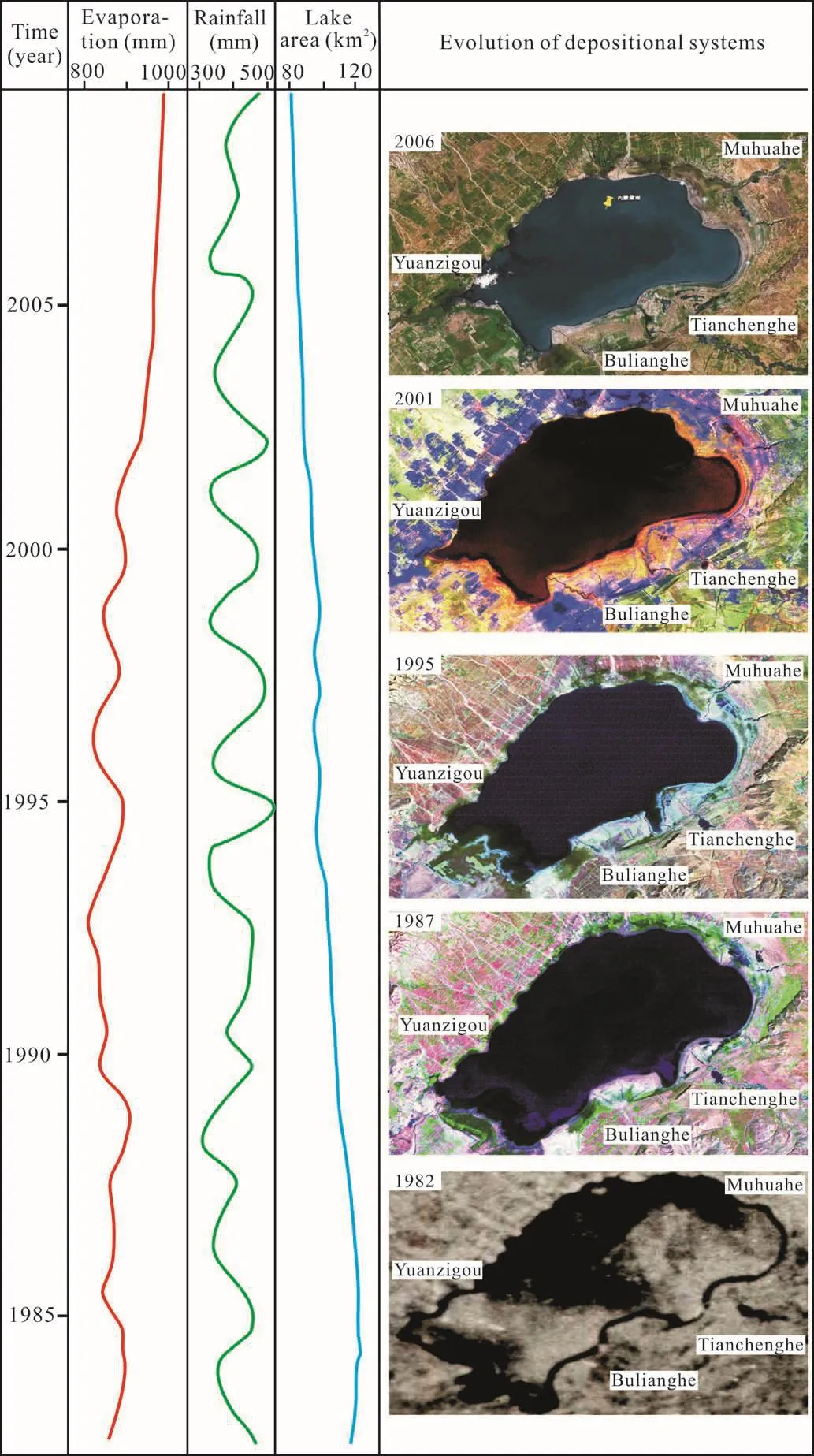
Fig.8 Evolution of depositional systems around Daihai Lake in the past 30 years.
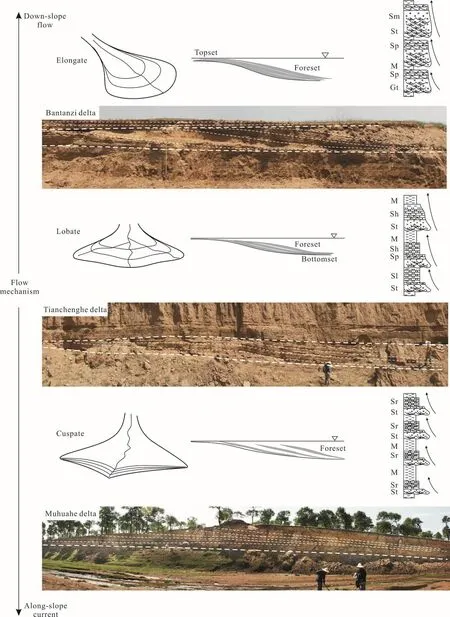
Fig.9 Tectonic controls on depositional systems and interaction between down-slope flows and along-slope currents.
7 Conclusions
(1)External geometry of the deltas around lacustrine rift basin was mainly controlled by slope gradients, characterized by a large number of fan-shape deltas in smaller dimension on steep slopes and a smaller number of lobe-shape deltas in larger dimension on gentle slopes.And deltas on axial shoaling margins were cuspate or bird-foot like, which depended on the interaction between the downslope flows and the along-slope currents.
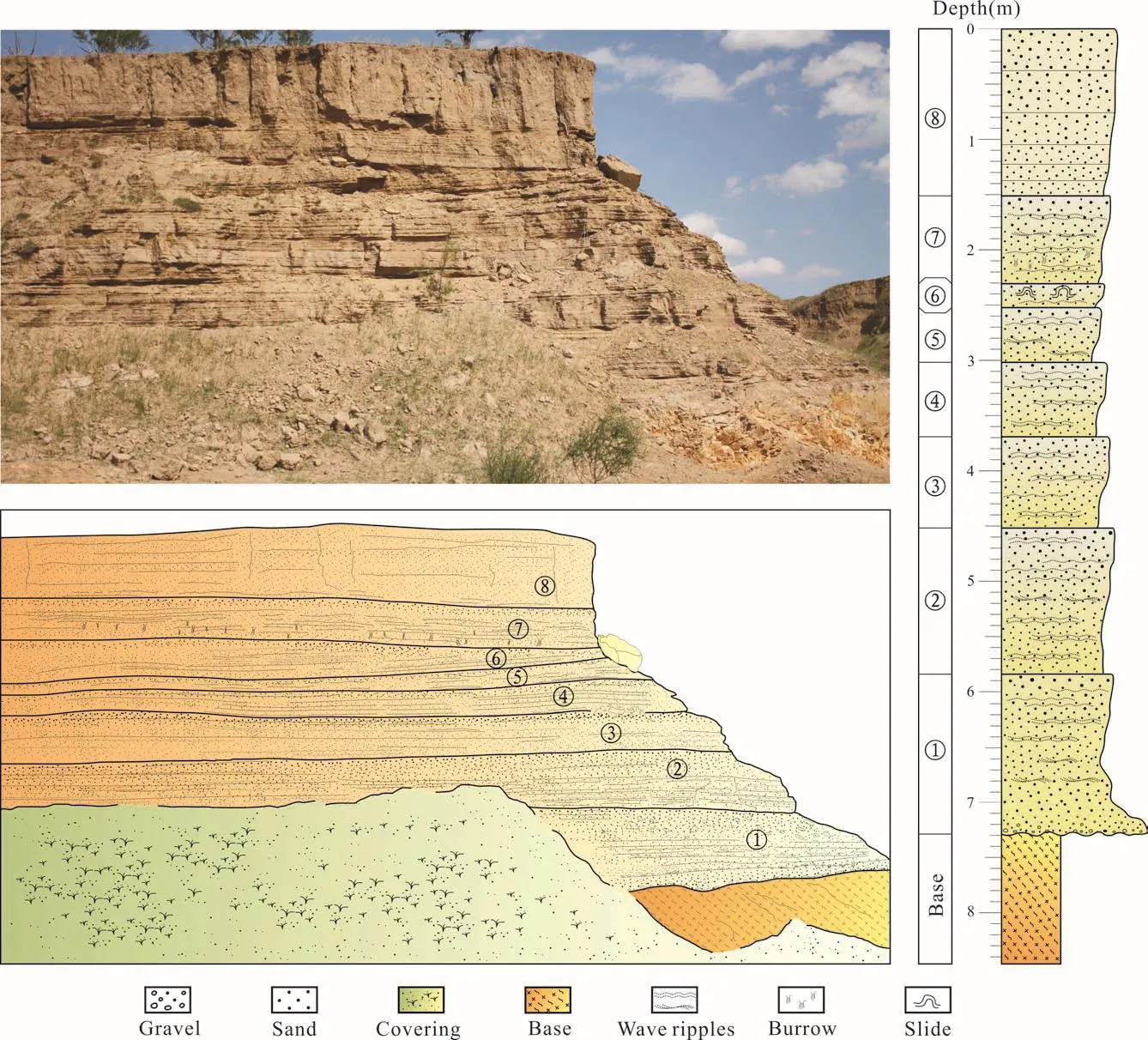
Fig.10 Evolution of Tiancheng delta in Daihai Lake.①-Characterized by gravels; ②-⑤-Fine-grain sand layers with plenty of wave ripples; ⑥-Foreset with slide structures; ⑦-Fine-grain sand layer with burrows; ⑧-A massive fine-grain sand layer.
(2)Profile sections of deltas were primarily influenced by topography and continuity of sediment supply.Sigmoidal foresets were developed on depositional slopes with steeper gradients; shingle foresets on depositional slopes with gentler gradients.The more continuous of sediment supply, the larger of delta progradation.Distributary channels on fine-grained deltas with plenty of muddy sediments incised deeper than those on coarse-grained deltas.
(3)Down-slope flows which are characterized by fluvial transportations interacted with along-slope currents which are characterized by the reworking of coastal waves when deltas were developed.Distributary bars were common on deltas when fluvial transportations were greater than coastal waves.Otherwise, the distal bar was predominant in the front of deltas.The interactions between the down-slope flows and the along-slope currents were also influenced by the topographic and climatic changes (rate of rainfall and evaporation).
Acknowledgements
This work was supported by the National Natural Science Foundation of China (No.41072084), the National Science and Technology Major Project (No.2011ZX05023-001-009)and the National Program on Key Basic Research Project (No.2009CB219502-3).We would like to thank Wang Nan and Zeng Xiaoming who dug trenches and collected data in field.Finally, we also thank all the field assistants who offered invaluable support to this research.
Barr, D., 1987.Structural stratigraphic models for extensional basins of half-graben type.Journal of Structural Geology, 9(4): 491-500.
Blair, T.C., McPherson, J.G., 1998.Recent debris-flow processes and resultant form and facies of the dolomite alluvial fan, Owens Valley, California.Journal of Sedimentary Research, 68(5):800-818.
Blair, T.C., McPherson, J.G., 2008.Quaternary sedimentology of the Rose Creek fan delta, Walker Lake, Nevada, USA, and implications to fan-delta facies models.Sedimentology, 55(3): 579-615.
Cao Jianting, Wang Suming, Sheng Ji, Zhang Zhenke, 2000.The paleoclimate changes during the past Millennium inferred from the lacustrine core in Daihai Lake, Inner Mongolia.Scientia Geographical Sinica, 5: 391-396.
Cohen, A., Ferguson, D., Gram, P., Hubler, S., Sims, K., 1986.The distribution of coarse-grained sediments in modern Lake Turkana, Kenya: Implications for clastic sedimentation models of rift lakes.Geological Society London Special Publications, 25(1):127-139.
Cohen, A.S., 1990.Tectono-stratigraphic model for sedimentation in Lake Tanganyika, Africa.In: Katz, B.J., (ed).Lacustrine Basin Exploration: Case Studies and Modern Analogs.137-150.
Coleman, J.M., 1982.Deltas: Processes of Deposition and Models for Exploration (Second Edition).Boston: International Human Resources Development Corporation.
Crossley, R., 1984.Controls of sedimentation in the Malawi rift valley, central Africa.Sedimentary Geology, 40(1-3): 33-50.
Fisher, J.A., Krapf, C.B.E., Lang, S.C., Nichols, G.J., Payenberg,T.H.D., 2008.Sedimentology and architecture of the Douglas Creek terminal splay, Lake Eyre, central Australia.Sedimentology, 55(6): 1915-1930.
Hans Nelson, C., Karabanov, E.B., Colman, S.M., Escutia, C., 1999.Tectonic and sediment supply control of deep rift lake turbidite systems: Lake Baikal, Russia.Geology, 27(2): 163-166.
Hutchinson, D.R., Golmshtok, A.J., Zonenshain, L.P., Moore, T.C.,Scholz, C.A., Klitgord, K.D., 1992.Depositional and tectonic framework of the rift basins of Lake Baikal from multichannel seismic data.Geology, 20(7): 589-592.
Jiang Zaixing, Chen Daizhao, Qiu Longwei, Liang Hongbin, Ma Jun, 2007.Source-controlled carbonates in a small Eocene halfgraben lake basin (Shulu Sag)in central Hebei Province, North China.Sedimentology, 54(2): 265-292.
Jin Zhangdong, 2001.Chemical Weathering and Paleo-environmental Change Since the Holocene in the Daihai Lake Watershed,Inner Mongolia.Doctoral Thesis, Graduate School of Chinese Academy of Sciences.
Johnson, T.C., Wells, J.D., Scholz, C.A., 1995.Deltaic sedimentation in a modern rift lake.Geological Society of America Bulletin, 107(7): 812-829.
Konate, M., Guiraud, M., Alidou, S., Clermonte, J., Drouet, J.J.,Lang J., 1994.Structuration and sedimentary dynamics of the Paleozoic half-graben shaped kandi basin, Benin, Niger.Comptes Rendus De l’Academie Des Sciences Serie II, 318: 535-542.
Li Huazhang, 1972.The formation of Daihai Lake and its topographical features.Journal of Beijing Normal University (natural science), 1: 23-32 (in Chinese).
McPherson, J.G., Shanmugam, G., Moiola, R.J., 1987.Fan-deltas and braid deltas: varieties of coarse-grained deltas.Bulletin of the Geological Society of America, 99(3): 331-340.
McPherson, J.G., Shanmugam, G., Moiola, R.J., 1988.Fan deltas and braid deltas: conceptual problems.In: Nemec, W., Steel, R.J., (eds).Fan Deltas: Sedimentology and Tectonic Settings.London: Blackie, 14-22.
Nemec, W., Steel, R.J., 1988.What is a fan delta and how do we recognize it? Fan Deltas: Sedimentology and Tectonic Settings.London: Blackie, 3-13.
Orton, G.J., 1988.A spectrum of Middle Ordovician fan deltas and braidplain deltas, North Wales: a consequence of varying fluvial clastic input.Fan delta: Sedimentology and Tectonic Settings.London: Blackie, 23-49.
Qiang, J., McCabe, P.J., 1998.Genetic features of petroleum systems in rift basins of eastern China.Marine and Petroleum Geology, 15(4): 343-358.
Qiu Yi′nan, 1992.The reservoir sedimentology advances of terrestrial clastic rocks, China.Acta Sedimentologica Sinica, 10: 16-24(in Chinese with English abstract).
Scholz, C.A., Rosendahl, B.R., 1990.Coarse-clastic facies and stratigraphic sequence models from lakes Malawi and Tanganyika, east Africa In: Katz, B.J., (ed).Lacustrine Basin Exploration:Case Studies and Modern Analogs.151-168.
Soreghan, M.J., Scholz, C.A., Wells, J.T., 1999.Coarse-grained,deep-water sedimentation along a border fault margin of Lake Malawi, Africa; seismic stratigraphic analysis.Journal of Sedimentary Research, 69(4): 832-846.
Wang Sumin, Wu Ruijin, Jiang Xinhe, 1990.Environment evolution and paleoclimate of Daihai lake, Inner Mongolia since the last glaciation.Quaternary Sciences, 10(3): 223-232.
Wells, J.T., Scholz, C.A., Soreghan, M.J., 1999.Processes of sedimentation on a lacustrine border-fault margin; interpretation of cores from Lake Malawi, East Africa.Journal of Sedimentary Research, 69(4): 816-831.
Yu Xinghe, Wang Defa, 1997.The architectural elements of the deltaic system in the terrestrial faulted basin and the significance of its reservoir geological model.Geological Review, 43: 225-231(in Chinese with English abstract).
Yu Xinghe, Wang Defa, Sun Zhihua, 1995.Lithofacies types, vertical profile features and reservoir geological models of braided deltaic sandstones in faulted lake basin.Acta Sedimentologica Sinica, 13: 48-58 (in Chinese with English abstract).
Yu Xinghe, Wang Defa, Zheng Junmao, Sun Zhihua, 1994.3-D extension models of braid deltaic sandbody in terrestrial facies.Acta Petrolei Sinica, 15: 26-37 (in Chinese with English abstract).
Zhu Guangyou, Jin Qiang, Dai Jinxing, Zhang Shuichang, Zhang Linye, Zhang Yingli, 2005.Composite hydrocarbon-generation system: An important concept for source rock evaluation and hydrocarbon prediction in rift lacustrine basin.Chinese Journal of Geology, 40(1): 133-144 (in Chinese with English abstract).
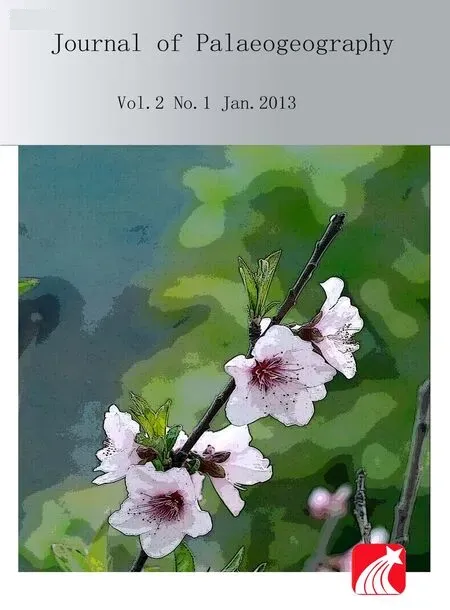 Journal of Palaeogeography2013年1期
Journal of Palaeogeography2013年1期
- Journal of Palaeogeography的其它文章
- Facies-succession and architecture of the thirdorder sequences and their stratigraphic framework of the Devonian in Yunnan-Guizhou-Guangxi area,South China
- Mesozoic lithofacies palaeogeography and petroleum prospectivity in North Carnarvon Basin, Australia
- Classifications, sedimentary features and facies associations of tidal f lats
- Review of research in internal-wave and internal-tide deposits of China
- The palaeobiogeography of South American gomphotheres
- Palaeobiogeographical constraints on the distribution of foraminifers and rugose corals in the Carboniferous Tindouf Basin, South Morocco
